Changes in Motor Competence after a Brief Physical Education Intervention Program in 4 and 5-Year-Old Preschool Children
Abstract
:1. Introduction
2. Materials and Methods
2.1. Study Design
2.2. Participants
2.3. Measurements
2.4. Procedures
2.5. Ethics
2.6. Statistical Analysis
3. Results
3.1. Baseline Characteristics
3.2. Control Group Outcomes
3.3. Experimental Group Outcomes
3.4. Experimental Group vs. Control Group Outcomes
4. Discussion
5. Conclusions
6. Study Limitations and Practical Applications
Author Contributions
Funding
Institutional Review Board Statement
Informed Consent Statement
Data Availability Statement
Conflicts of Interest
References
- Malina, R.M. Top 10 research questions related to growth and maturation of relevance to physical activity, performance, and fitness. Res. Q. Exerc. Sport 2014, 85, 157–173. [Google Scholar] [CrossRef]
- Henderson, S.E.; Sugden, D.A. Movement Assessment Battery for Children; The Psychological Corporation: Kent, UK, 1992; ISBN 0749101350. [Google Scholar]
- Gabbard, C.P. Lifelong Motor Development: Pearson New International Edition, 6th ed.; Pearson Higher Education: Philadelphia, PA, USA, 2013; ISBN 0321830253. [Google Scholar]
- Stodden, D.F.; Goodway, J.D.; Langendorfer, S.J.; Roberton, M.A.; Rudisill, M.E.; Garcia, C.; Garcia, L.E. A Developmental perspective on the role of motor skill competence in physical activity: An emergent relationship. Quest 2008, 60, 290–306. [Google Scholar] [CrossRef]
- Escolano-Pérez, E.; Herrero-Nivela, M.L.; Losada, J.L. Association between preschoolers’ specific fine (but not gross) motor skills and later academic competencies: Educational implications. Front. Psychol. 2020, 11, 1044. [Google Scholar] [CrossRef] [PubMed]
- Piek, J.P.; Baynam, G.B.; Barrett, N.C. The relationship between fine and gross motor ability, self-perceptions and self-worth in children and adolescents. Hum. Mov. Sci. 2006, 25, 65–75. [Google Scholar] [CrossRef]
- Davis, J.L.; Matthews, R.N. NEPSY-II Review: Korkman, M., Kirk, U., & Kemp, S. (2007). NEPSY—Second Edition (NEPSY-II). San Antonio, TX: Harcourt Assessment. J. Psychoeduc. Assess. 2010, 28, 175–182. [Google Scholar] [CrossRef]
- Loprinzi, P.D.; Cardinal, B.J.; Loprinzi, K.L.; Lee, H. Benefits and environmental determinants of physical activity in children and adolescents. Obes. Facts 2012, 5, 597–610. [Google Scholar] [CrossRef] [PubMed]
- Gallahue, D.L.; Ozmun, J.C.; Goodway, J. Understanding Motor Development: Infants, Children, Adolescents, Adults, 7th ed.; McGraw-Hill: New York, NY, USA, 2012; ISBN 9780073376509. [Google Scholar]
- Flôres, F.S.; Rodrigues, L.P.; Copetti, F.; Lopes, F.; Cordovil, R. Affordances for motor skill development in home, school, and sport environments: A narrative review. Percept. Mot. Skills 2019, 126, 366–388. [Google Scholar] [CrossRef] [PubMed]
- Niemistö, D.; Finni, T.; Haapala, E.A.; Cantell, M.; Korhonen, E.; Sääkslahti, A. Environmental correlates of motor competence in children—The Skilled Kids Study. Int. J. Environ. Res. Public Health 2019, 16, 1989. [Google Scholar] [CrossRef] [Green Version]
- Logan, S.; Robinson, L.; Webster, E.K.; Barber, L. Exploring preschoolers’ engagement and perceived physical competence in an autonomy-based object control skill intervention: A preliminary study. Eur. Phys. Educ. Rev. 2013, 19, 302–314. [Google Scholar] [CrossRef]
- Gobierno de España. Real Decreto 1630/2006, de 29 de Diciembre, por el que se Establecen las Enseñanzas Mínimas del Segundo Ciclo de Educación Infantil; Gobierno de España: Madrid, Spain, 2006. [Google Scholar]
- WHO. Global Recommendations on Physical Activity for Health; WHO: Geneva, Switzerland, 2010. [Google Scholar]
- WHO. Guidelines on Physical Activity, Sedentary Behaviour and Sleep for Children Under 5 Years of Age; WHO: Geneva, Switzerland, 2019. [Google Scholar]
- Zimmer, R.; Cicurs, H. Psychomotorik; Hofmann Verla: Schorndorf, Germany, 1993; ISBN 978-3778099056. [Google Scholar]
- Rose, B.; Larkin, D.; Berger, B.G. Coordination and Gender Influences on the Perceived Competence of Children. Adapt. Phys. Act. Q. 1997, 14, 210–221. [Google Scholar] [CrossRef]
- Freitas, C.; Vasconcelos, M.O.; Botelho, M. Handedness and developmental coordination disorder in Portuguese children: Study with the M-ABC test. Laterality 2014, 19, 655–676. [Google Scholar] [CrossRef]
- Jelovčan, G.; Zurc, J. Preschool children’s results in movement ABC test: Differences between girls and boys in movement deficit. Ann. Kinesiol. 2016, 7, 3–19. [Google Scholar]
- Navarro-Patón, R.; Arufe-Giráldez, V.; Sanmiguel-Rodríguez, A.; Mecías-Calvo, M. Differences on motor competence in 4-year-old boys and girls regarding the quarter of birth: Is there a relative age effect? Children 2021, 8, 141. [Google Scholar] [CrossRef] [PubMed]
- Navarro-Patón, R.; Lago-Ballesteros, J.; Arufe-Giráldez, V.; Sanmiguel-Rodríguez, A.; Lago-Fuentes, C.; Mecías-Calvo, M. Gender differences on motor competence in 5-year-old preschool children regarding relative age. Int. J. Environ. Res. Public Health 2021, 18, 3143. [Google Scholar] [CrossRef]
- Navarro-Patón, R.; Mecías-Calvo, M.; Rodríguez Fernández, J.E.; Arufe-Giráldez, V. Relative age effect on motor competence in children aged 4–5 years. Children 2021, 8, 115. [Google Scholar] [CrossRef]
- Olesen, L.G.; Kristensen, P.L.; Ried-Larsen, M.; Grøntved, A.; Froberg, K. Physical activity and motor skills in children attending 43 preschools: A cross-sectional study. BMC Pediatr. 2014, 14, 229. [Google Scholar] [CrossRef] [Green Version]
- Da Silva Oliveira, D.; de Oliveira, I.S.; Cattuzzo, M.T. A influência do gênero e idade no desempenho das habilidades locomotoras de crianças de primeira infância. Rev. Bras. Educ. Física Esporte 2013, 27, 647–655. [Google Scholar] [CrossRef] [Green Version]
- Vedul-Kjelsås, V.; Stensdotter, A.-K.; Sigmundsson, H. Motor competence in 11-year-old boys and girls. Scand. J. Educ. Res. 2013, 57, 561–570. [Google Scholar] [CrossRef]
- Valtr, L.; Psotta, R.; Abdollahipour, R. Gender differences in performance of the Movement Assessment Battery forChildren—2nd edition test in adolescents. Acta Gymnica 2016, 46, 155–161. [Google Scholar] [CrossRef] [Green Version]
- Kita, Y.; Suzuki, K.; Hirata, S.; Sakihara, K.; Inagaki, M.; Nakai, A. Applicability of the Movement Assessment Battery for Children-Second Edition to Japanese children: A study of the Age Band 2. Brain Dev. 2016, 38, 706–713. [Google Scholar] [CrossRef] [PubMed]
- Kokštejn, J.; Musálek, M.; Tufano, J.J. Are sex differences in fundamental motor skills uniform throughout the entire preschool period? PLoS ONE 2017, 12, e0176556. [Google Scholar] [CrossRef] [PubMed]
- Mathisen, G.E. Motor competence and implications in primary school. J. Phys. Educ. Sport 2016, 16, 206–209. [Google Scholar] [CrossRef]
- McIntosh, D.E.; Gibney, L.; Quinn, K.; Kundert, D. Concurrent validity of the early screening profiles and the differential ability scales with an at-risk preschool sample. Psychol. Sch. 2000, 37, 201–207. [Google Scholar] [CrossRef]
- Cools, W.; de Martelaer, K.; Samaey, C.; Andries, C. Movement skill assessment of typically developing preschool children: A review of seven movement skill assessment tools. J. Sports Sci. Med. 2009, 8, 154–168. [Google Scholar]
- Scheuer, C.; Herrmann, C.; Bund, A. Motor tests for primary school aged children: A systematic review. J. Sports Sci. 2019, 37, 1097–1112. [Google Scholar] [CrossRef]
- Logan, S.W.; Robinson, L.E.; Wilson, A.E.; Lucas, W.A. Getting the fundamentals of movement: A meta-analysis of the effectiveness of motor skill interventions in children. Child. Care. Health Dev. 2012, 38, 305–315. [Google Scholar] [CrossRef] [PubMed]
- Payne, V.G.; Isaacs, L.D. Human Motor Development: A Lifespan Approach, 9th ed.; Routledge: London, UK, 2017; ISBN 9781621590439. [Google Scholar]
- Palmer, K.K.; Stodden, D.F.; Ulrich, D.A.; Robinson, L.E. Using process- and product-oriented measures to evaluate changes in motor skills across an intervention. Meas. Phys. Educ. Exerc. Sci. 2021, 1–10. [Google Scholar] [CrossRef]
- Logan, S.W.; Barnett, L.M.; Goodway, J.D.; Stodden, D.F. Comparison of performance on process- and product-oriented assessments of fundamental motor skills across childhood. J. Sports Sci. 2017, 35, 634–641. [Google Scholar] [CrossRef]
- Lander, N.; Morgan, P.J.; Salmon, J.; Barnett, L.M. Teachers’ perceptions of a fundamental movement skill (FMS) assessment battery in a school setting. Meas. Phys. Educ. Exerc. Sci. 2016, 20, 50–62. [Google Scholar] [CrossRef] [Green Version]
- Lander, N.; Morgan, P.J.; Salmon, J.; Logan, S.W.; Barnett, L.M. The reliability and validity of an authentic motor skill assessment tool for early adolescent girls in an Australian school setting. J. Sci. Med. Sport 2017, 20, 590–594. [Google Scholar] [CrossRef] [PubMed] [Green Version]
- Henderson, S.E.; Sudgen, D.A.; Barnett, A. Movement Assessment Battery for Children-2, 2nd ed.; The Psychological Corporation: London, UK, 2007; ISBN 9780749101671. [Google Scholar]
- Jiménez Díaz, J.; Salazar Rojas, W.; Morera Castro, M. Age and gender differences in fundamental motor skills. Pensar Mov. Rev. Ciencias Ejerc. Salud 2015, 13, 4. [Google Scholar] [CrossRef] [Green Version]
- Pombo, A.; Luz, C.; de Sá, C.; Rodrigues, L.P.; Cordovil, R. Effects of the COVID-19 Lockdown on Portuguese children’s motor competence. Children 2021, 8, 199. [Google Scholar] [CrossRef] [PubMed]
- Riethmuller, A.M.; Jones, R.A.; Okely, A.D. Efficacy of interventions to improve motor development in young children: A systematic review. Pediatrics 2009, 124, e782–e792. [Google Scholar] [CrossRef]
- Hardy, L.L.; Reinten-Reynolds, T.; Espinel, P.; Zask, A.; Okely, A.D. Prevalence and correlates of low fundamental movement skill competency in children. Pediatrics 2012, 130, e390–e398. [Google Scholar] [CrossRef] [PubMed]
- Barnett, L.M.; Lai, S.K.; Veldman, S.L.C.; Hardy, L.L.; Cliff, D.P.; Morgan, P.J.; Zask, A.; Lubans, D.R.; Shultz, S.P.; Ridgers, N.D.; et al. Correlates of gross motor competence in children and adolescents: A systematic review and meta-analysis. Sport. Med. 2016, 46, 1663–1688. [Google Scholar] [CrossRef] [Green Version]
- Robinson, L.E.; Goodway, J.D. Instructional climates in preschool children who are at-risk. Part I. Res. Q. Exerc. Sport 2009, 80, 533–542. [Google Scholar] [CrossRef]
- Goodway, J.D.; Famelia, R.; Bakhtiar, S. Future directions in physical education & sport: Developing fundamental motor competence in the early years is paramount to lifelong physical activity. Asian Soc. Sci. 2014, 10, 44–54. [Google Scholar] [CrossRef] [Green Version]
- Clark, J.E. From the beginning: A developmental perspective on movement and mobility. Quest 2005, 57, 37–45. [Google Scholar] [CrossRef]
- Valentini, N.C.; Ramalho, M.H.; Oliveira, M.A. Movement assessment battery for children-2: Translation, reliability, and validity for Brazilian children. Res. Dev. Disabil. 2014, 35, 733–740. [Google Scholar] [CrossRef]
- Robinson, L.E. Effect of a mastery climate motor program on object control skills and perceived physical competence in preschoolers. Res. Q. Exerc. Sport 2011, 82, 355–359. [Google Scholar] [CrossRef]
- Lai, S.K.; Costigan, S.A.; Morgan, P.J.; Lubans, D.R.; Stodden, D.F.; Salmon, J.; Barnett, L.M. Do school-based interventions focusing on physical activity, fitness, or fundamental movement skill competency produce a sustained impact in these outcomes in children and adolescents? A systematic review of follow-up studies. Sport. Med. 2014, 44, 67–79. [Google Scholar] [CrossRef]
- Morgan, P.J.; Barnett, L.M.; Cliff, D.P.; Okely, A.D.; Scott, H.A.; Cohen, K.E.; Lubans, D.R. Fundamental movement skill interventions in youth: A systematic review and meta-analysis. Pediatrics 2013, 132, e1361–e1383. [Google Scholar] [CrossRef] [Green Version]
- Veldman, S.L.C.; Jones, R.A.; Okely, A.D. Efficacy of gross motor skill interventions in young children: An updated systematic review. BMJ Open Sport Exerc. Med. 2016, 2, e000067. [Google Scholar] [CrossRef]
- Wick, K.; Leeger-Aschmann, C.S.; Monn, N.D.; Radtke, T.; Ott, L.V.; Rebholz, C.E.; Cruz, S.; Gerber, N.; Schmutz, E.A.; Puder, J.J.; et al. Interventions to promote fundamental movement skills in childcare and kindergarten: A systematic review and meta-analysis. Sport. Med. 2017, 47, 2045–2068. [Google Scholar] [CrossRef] [Green Version]
- Jiménez-Díaz, J.; Chaves-Castro, K.; Salazar, W. Effects of different movement programs on motor competence: A systematic review with meta-analysis. J. Phys. Act. Health 2019, 16, 657–666. [Google Scholar] [CrossRef]
- Van Capelle, A.; Broderick, C.R.; van Doorn, N.; Ward, R.E.; Parmenter, B.J. Interventions to improve fundamental motor skills in pre-school aged children: A systematic review and meta-analysis. J. Sci. Med. Sport 2017, 20, 658–666. [Google Scholar] [CrossRef]
- Hammond, J.; Jones, V.; Hill, E.L.; Green, D.; Male, I. An investigation of the impact of regular use of the Wii Fit to improve motor and psychosocial outcomes in children with movement difficulties: A pilot study. Child. Care. Health Dev. 2014, 40, 165–175. [Google Scholar] [CrossRef] [PubMed] [Green Version]
- Monsalves-Álvarez, M.; Castro-Sepúlveda, M.; Zapata-Lamana, R.; Rosales-Soto, G.; Salazar, G. Motor skills and nutritional status outcomes from a physical activity intervention in short breaks on preschool children conducted by their educators: A pilot study. Nutr. Hosp. 2015, 32, 1576–1581. [Google Scholar] [CrossRef]
- Ato, M.; López, J.J.; Benavente, A. Un sistema de clasificación de los diseños de investigación en psicología. An. Psicol. 2013, 29, 1038–1059. [Google Scholar] [CrossRef] [Green Version]
- Graupera, J.L.; Ruiz, L.M. Batería de Evaluación del Movimiento para Niños-2; Pearson: Madrid, Spain, 2012; Volume 2. [Google Scholar]
- Schoemaker, M.M.; Niemeijer, A.S.; Flapper, B.C.T.; Smits-Engelsman, B.C.M. Validity and reliability of the Movement Assessment Battery for Children-2 Checklist for children with and without motor impairments. Dev. Med. Child Neurol. 2012, 54, 368–375. [Google Scholar] [CrossRef] [PubMed]
- Serbetar, I.; Loftesnes, J.M.; Mamen, A. Reliability and structural validity of the movement Assessment Battery for Children-2 in Croatian preschool children. Sports 2019, 7, 248. [Google Scholar] [CrossRef] [Green Version]
- Navarro-Patón, R.; Martín-Ayala, J.L.; Martí González, M.; Hernández, A.; Mecías-Calvo, M. Effect of a 6-Week Physical Education Intervention on Motor Competence in Pre-School Children with Developmental Coordination Disorder. J. Clin. Med. 2021, 10, 1936. [Google Scholar] [CrossRef] [PubMed]
- Kalaja, S.P.; Jaakkola, T.T.; Liukkonen, J.O.; Digelidis, N. Development of junior high school students’ fundamental movement skills and physical activity in a naturalistic physical education setting. Phys. Educ. Sport Pedagog. 2012, 17, 411–428. [Google Scholar] [CrossRef]
- Goodway, J.D.; Branta, C.F. Influence of a motor skill intervention on fundamental motor skill development of disadvantaged preschool children. Res. Q. Exerc. Sport 2003, 74, 36–46. [Google Scholar] [CrossRef] [PubMed]
- Veldman, S.L.C.; Jones, R.A.; Santos, R.; Sousa-Sá, E.; Okely, A.D. Gross motor skills in toddlers: Prevalence and socio-demographic differences. J. Sci. Med. Sport 2018, 21, 1226–1231. [Google Scholar] [CrossRef]
- Venter, A.; Pienaar, A.E.; Coetzee, D. Extent and nature of motor difficulties based on age, ethnicity, gender and socio-economic status in a selected group of three-to five-year-old children. S. Afr. J. Res. Sport. Phys. Educ. Recreat. 2015, 37, 169–183. [Google Scholar]
- Golding, J.; Emmett, P.; Iles-Caven, Y.; Steer, C.; Lingam, R. A review of environmental contributions to childhood motor skills. J. Child Neurol. 2014, 29, 1531–1547. [Google Scholar] [CrossRef] [PubMed] [Green Version]
- Herrmann, C.; Gerlach, E.; Seelig, H. Development and validation of a test instrument for the assessment of basic motor competencies in primary school. Meas. Phys. Educ. Exerc. Sci. 2015, 19, 80–90. [Google Scholar] [CrossRef]
- Morley, D.; Till, K.; Ogilvie, P.; Turner, G. Influences of gender and socioeconomic status on the motor proficiency of children in the UK. Hum. Mov. Sci. 2015, 44, 150–156. [Google Scholar] [CrossRef]
- Behan, S.; Belton, S.; Peers, C.; O’Connor, N.E.; Issartel, J. Moving well-being well: Investigating the maturation of fundamental movement skill proficiency across sex in Irish children aged five to twelve. J. Sports Sci. 2019, 37, 2604–2612. [Google Scholar] [CrossRef]
- Bolger, L.E.; Bolger, L.A.; O’Neill, C.; Coughlan, E.; O’Brien, W.; Lacey, S.; Burns, C. The Effectiveness of Two Interventions on Fundamental Movement Skill Proficiency among a Cohort of Irish Primary School Children. J. Mot. Learn. Dev. 2019, 7, 153–179. [Google Scholar] [CrossRef]
- Cohen, K.E.; Morgan, P.J.; Plotnikoff, R.C.; Calliester, R.; Lubans, D.R. Physical Activity and Skills Intervention: SCORES Cluster Randomized Controlled Trial. Med. Sci. Sport. Exerc. 2015, 47, 765–774. [Google Scholar] [CrossRef]
- Hardman, K.; Marshall, J.; Brandl-Bredenbeck, H.P.; Brettschneider, W.; Costa, F.C.D.; Klein, G.; Patriksson, G.; Rychtecký, A. Current Situation and Prospects for Physical Education in the European Union; European Parliament: Brussels, Belgium, 2006. [Google Scholar]
- Bakhtiari, S.; Shafinia, P.; Ziaee, V. Effects of selected exercises on elementary school third grade girl students’ motor development. Asian J. Sports Med. 2011, 2, 51–56. [Google Scholar] [CrossRef] [PubMed] [Green Version]
- Boyle-Holmes, T.; Grost, L.; Russell, L.; Laris, B.A.; Robin, L.; Haller, E.; Potter, S.; Lee, S. Promoting elementary physical education: Results of a school-based evaluation study. Health Educ. Behav. 2009, 37, 377–389. [Google Scholar] [CrossRef]
- Heil, D.P. Predicting activity energy expenditure using the Actical® Activity Monitor. Res. Q. Exerc. Sport 2006, 77, 64–80. [Google Scholar] [CrossRef] [PubMed]
- Vidoni, C.; Lorenz, D.J.; de Paleville, D.T. Incorporating a movement skill programme into a preschool daily schedule. Early Child Dev. Care 2014, 184, 1211–1222. [Google Scholar] [CrossRef]
- Bolger, L.E.; Bolger, L.A.; Neill, C.O.; Coughlan, E.; O’Brien, W.; Lacey, S.; Burns, C. Age and sex differences in fundamental movement skills among a cohort of Irish school children. J. Mot. Learn. Dev. 2018, 6, 81–100. [Google Scholar] [CrossRef]
- Kelly, L.; O’Connor, S.; Harrison, A.J.; Ní Chéilleachair, N.J. Does fundamental movement skill proficiency vary by sex, class group or weight status? Evidence from an Irish primary school setting. J. Sports Sci. 2019, 37, 1055–1063. [Google Scholar] [CrossRef]
- Martin, E.H.; Rudisill, M.E.; Hastie, P.A. Motivational climate and fundamental motor skill performance in a naturalistic physical education setting. Phys. Educ. Sport Pedagog. 2009, 14, 227–240. [Google Scholar] [CrossRef]
- Kelly, L.; O’Connor, S.; Harrison, A.J.; Ní Chéilleachair, N.J. Effects of an 8-week school-based intervention programme on Irish school children’s fundamental movement skills. Phys. Educ. Sport Pedagog. 2020, 1–20. [Google Scholar] [CrossRef]
- Newell, K.M. Constraints on the Development of Coordination. In Motor Development in Children: Aspects of Coordination and Control; Springer: Amsterdam, The Netherlands, 1986; pp. 341–360. [Google Scholar]
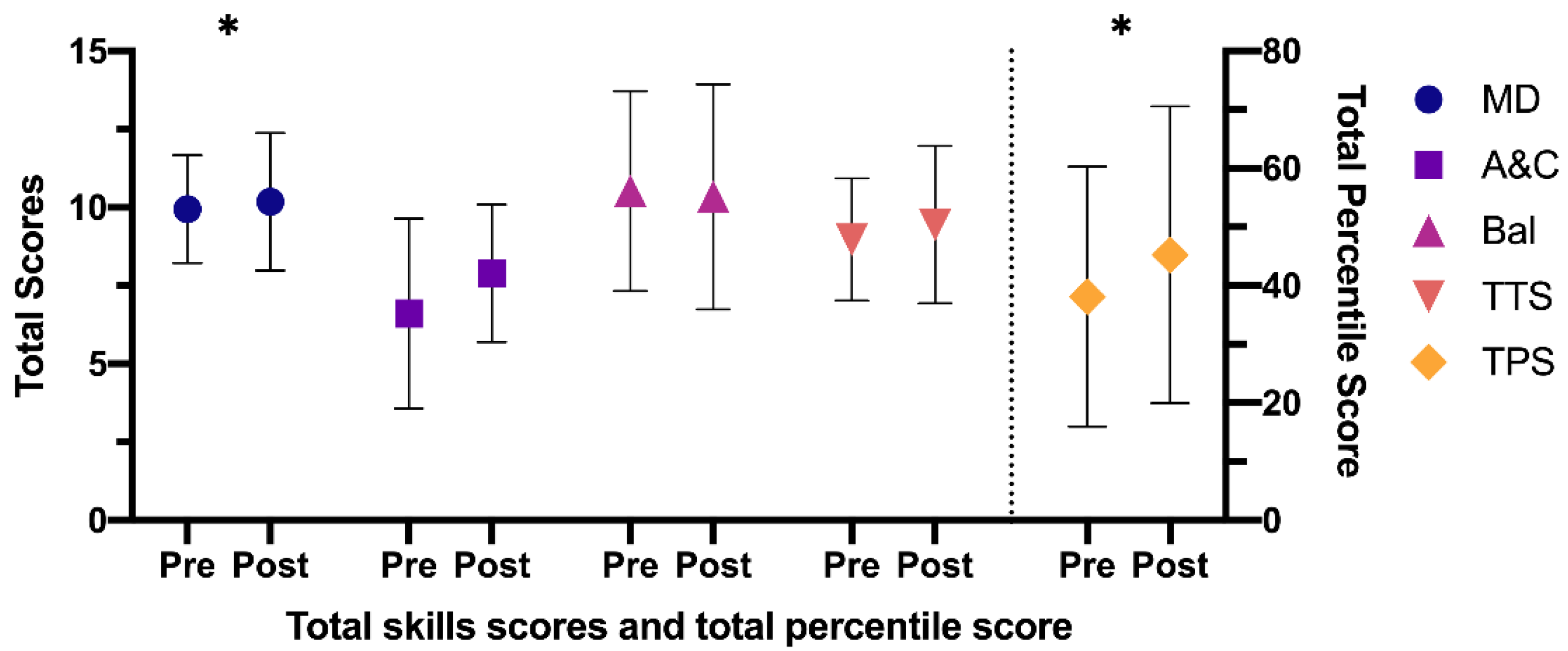
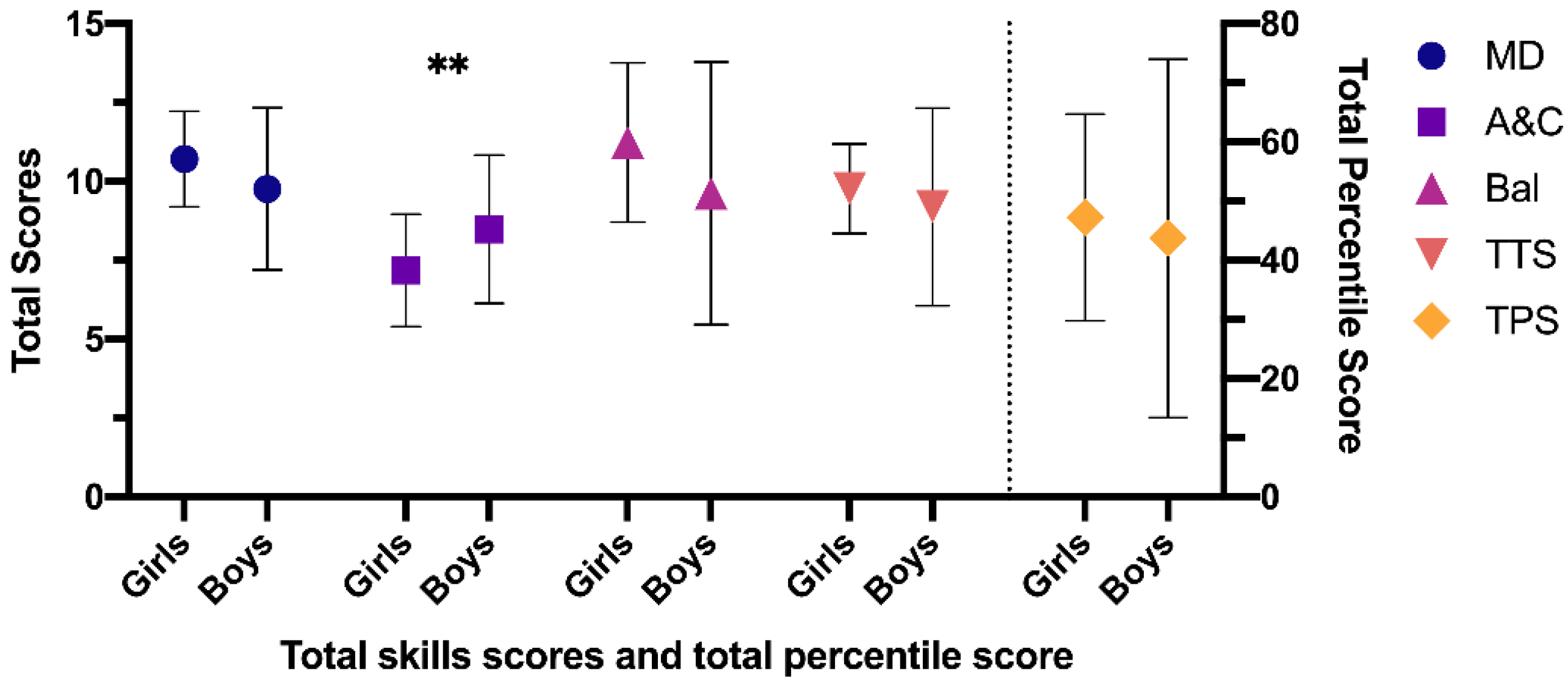
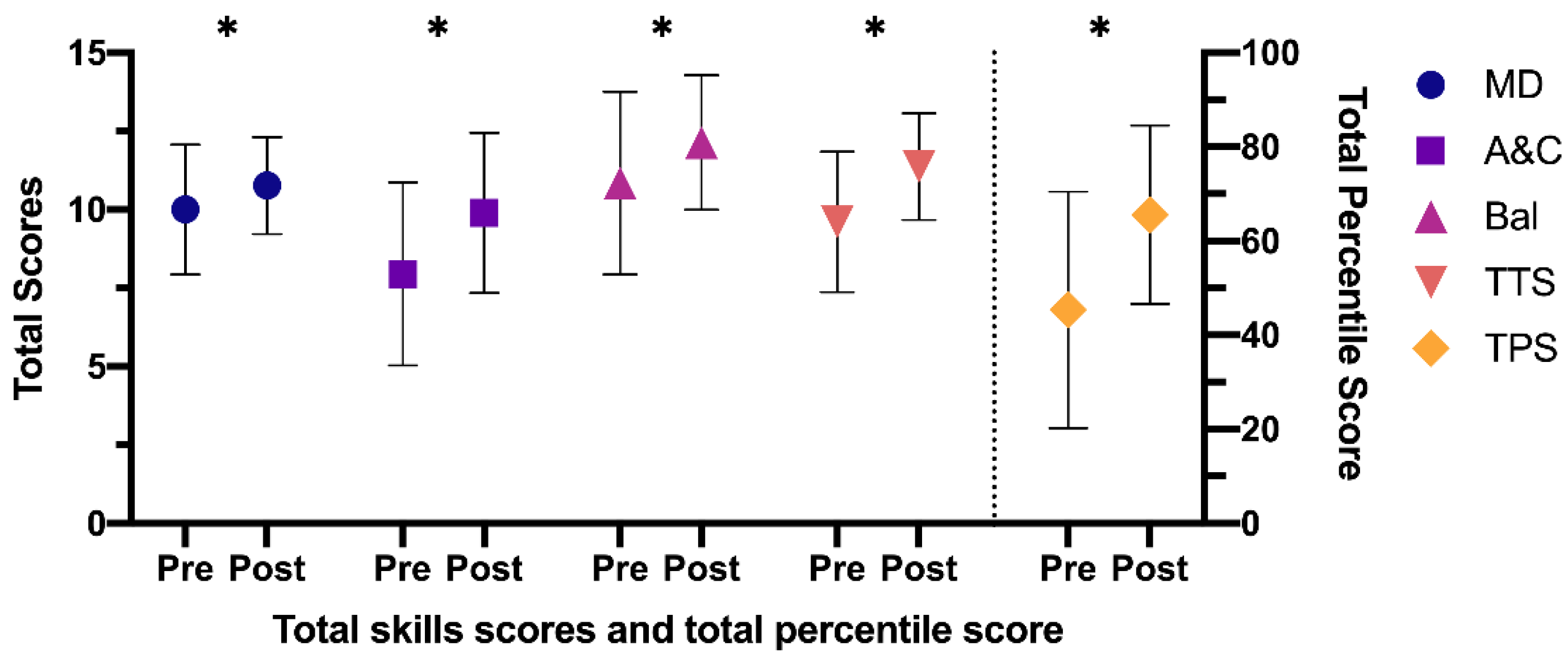
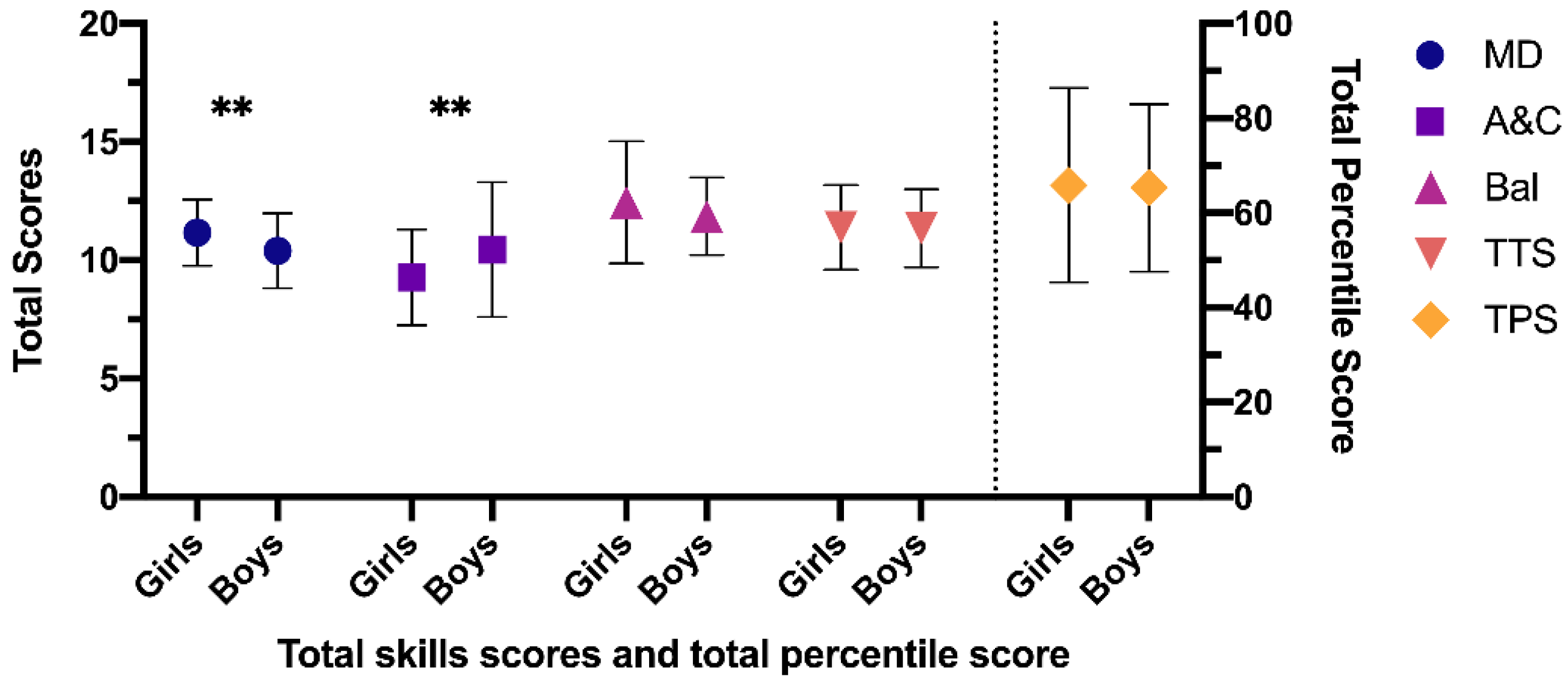
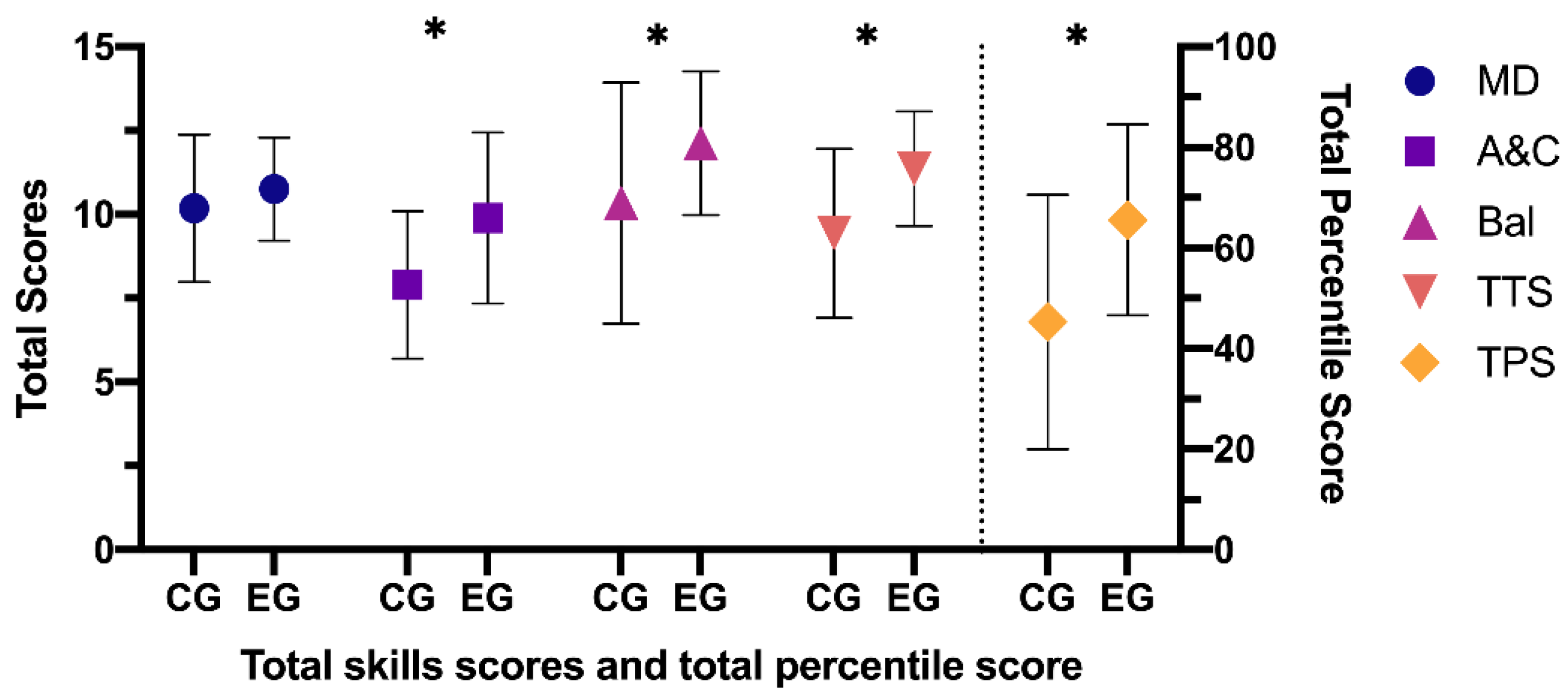
| Session Number | Objectives | Tasks (Skills) |
|---|---|---|
| Session 1 “I explore my body” | Introduce manual dexterity, balance and global throwing and catching skills through games | “We play with the tweezers” (manual dexterity) “Balance chase game” (balance) “Do not fall!” (aiming and catching) “Manual golf” (aiming and catching) “The jumping kangaroos” (balance) |
| Session 2 “I develop my motor skills” | Improve fine motor and manual dexterity, jot down tasks, grasp and balance | “Wrap the giraffe” (manual dexterity) “Shooting into the tunnel” (aiming and catching) “Balance circuit” (balance) |
| Session 3 “The art of catching” | Develop manual dexterity with both hands and practice the tasks of catching and receiving various objects | “Chinese carriers” (manual dexterity) “Catch practice” (catching) “Catch and win” (catching) “Molded animals” (manual dexterity) |
| Session 4 “Sharpen your aim” | Improve fine motor skills in both hands. Develop aim and precision when throwing objects | “The coin catcher” (manual dexterity) “Aim for the bullseye” (aiming) “Double throw” (aiming and catching) “The labyrinth” (manual dexterity) |
| Session 5: “Circus tightrope walkers” | Work on manual dexterity and fine motor skills, develop static and dynamic balance. | “Paste-stickers” (manual dexterity) “The stilts” (balance) “The rescue” (balance and aiming and catching) “The endless line” (balance) “To pick up!” |
| Session 6: “Motor circuits” | Remember through the motor circuit, tasks and games performed in previous sessions. Work with manual dexterity, aiming, grip and balancing | “The circuit” (manual dexterity; aiming and catching; balance) “Circuit 1” (manual dexterity; aiming and catching; balance) “Circuit 2” (manual dexterity; aiming and catching; balance) |
| Total Scores | Total (n = 152) | Control Group (n = 76) | Experimental Group (n = 76) | ||||||
|---|---|---|---|---|---|---|---|---|---|
| All | Male (n = 82) | Female (n = 70) | All | Male (n = 42) | Female (n = 34) | All | Male (n = 40) | Female (n = 36) | |
| Manual Dexterity | 9.97 ± 1.89 | 9.46 ± 1.84 | 10.57 ± 1.79 | 9.94 ± 1.72 | 9.80 ± 1.51 | 10.11 ± 1.96 | 10.00 ± 2.06 | 9.10 ± 2.09 | 11.00 ± 1.51 |
| Total score for aiming and catching | 7.27 ± 3.04 | 7.46 ± 2.94 | 7.05 ± 3.15 | 6.60 ± 3.03 | 7.00 ± 2.99 | 6.11 ± 3.05 | 7.94 ± 2.92 | 7.95 ± 2.85 | 7.94 ± 3.03 |
| Total score for balance | 10.68 ± 3.05 | 9.78 ± 3.00 | 11.74 ± 2.76 | 10.52 ± 3.18 | 9.71 ± 3.12 | 11.52 ± 3.02 | 10.84 ± 2.91 | 9.85 ± 2.90 | 11.94 ± 2.54 |
| Total 8 test Score | 9.28 ± 2.11 | 8.73± 1.85 | 9.94 ± 2.21 | 8.97 ± 1.95 | 8.76 ± 1.87 | 9.23 ± 2.04 | 9.60 ± 2.23 | 8.70 ± 1.87 | 10.61 ± 2.19 |
| Total Percentile Score | 41.72 ± 23.87 | 35.48 ± 21.01 | 49.02 ± 25.07 | 38.10 ± 22.16 | 35.76 ± 21.51 | 41.00 ± 22.94 | 45.34 ± 25.09 | 35.20 ± 20.73 | 56.61 ± 24.93 |
Publisher’s Note: MDPI stays neutral with regard to jurisdictional claims in published maps and institutional affiliations. |
© 2021 by the authors. Licensee MDPI, Basel, Switzerland. This article is an open access article distributed under the terms and conditions of the Creative Commons Attribution (CC BY) license (https://creativecommons.org/licenses/by/4.0/).
Share and Cite
Navarro-Patón, R.; Brito-Ballester, J.; Villa, S.P.; Anaya, V.; Mecías-Calvo, M. Changes in Motor Competence after a Brief Physical Education Intervention Program in 4 and 5-Year-Old Preschool Children. Int. J. Environ. Res. Public Health 2021, 18, 4988. https://doi.org/10.3390/ijerph18094988
Navarro-Patón R, Brito-Ballester J, Villa SP, Anaya V, Mecías-Calvo M. Changes in Motor Competence after a Brief Physical Education Intervention Program in 4 and 5-Year-Old Preschool Children. International Journal of Environmental Research and Public Health. 2021; 18(9):4988. https://doi.org/10.3390/ijerph18094988
Chicago/Turabian StyleNavarro-Patón, Rubén, Julien Brito-Ballester, Silvia Pueyo Villa, Vanessa Anaya, and Marcos Mecías-Calvo. 2021. "Changes in Motor Competence after a Brief Physical Education Intervention Program in 4 and 5-Year-Old Preschool Children" International Journal of Environmental Research and Public Health 18, no. 9: 4988. https://doi.org/10.3390/ijerph18094988
APA StyleNavarro-Patón, R., Brito-Ballester, J., Villa, S. P., Anaya, V., & Mecías-Calvo, M. (2021). Changes in Motor Competence after a Brief Physical Education Intervention Program in 4 and 5-Year-Old Preschool Children. International Journal of Environmental Research and Public Health, 18(9), 4988. https://doi.org/10.3390/ijerph18094988








